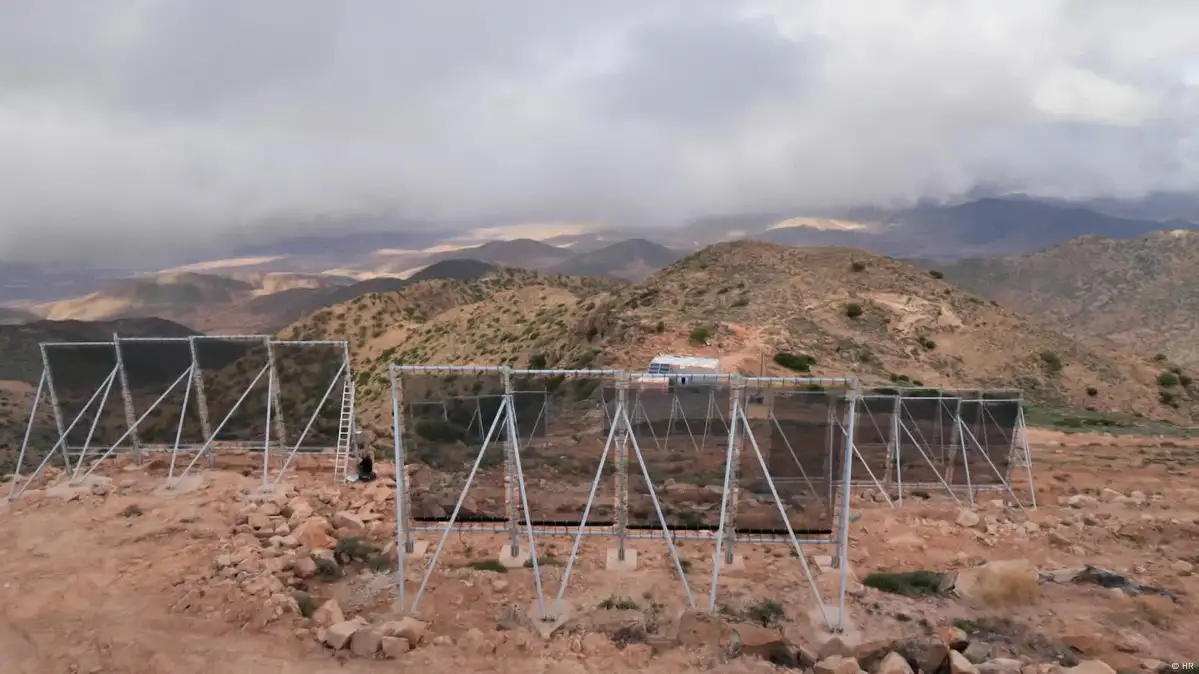Turning vapor into drinking water: a bizarre response to the impact of climate change? Or a stroke of genius? ItвҖҷs hoped that the cloud catchers – nets that fish water out of the air – will provide a solution to water shortages worldwide. But how does it work?
Two billion people across the world lack access to clean drinking water. Whole areas are drying up, while fires are destroying forests and soil. The film portrays people on the Canary Islands in Spain and in Morocco who are meeting the specter of drought with innovative new projects.
The Intergovernmental Panel on Climate Change predicts that North Africa will lose around 50 per cent of its available surface water this century. The forecasts for Spain are similar. Studies say that 75 per cent of the country is at risk of desertification. In the south of the country, villages already rely on tanker lorries to bring them water when the pipes dry up – for months on end. Research into alternative water sources is of paramount importance, here.
The European Union is funding the “Life Nieblas” project to find out more about the cloud catchersвҖҷ potential. In the north of Gran Canaria, researchers have managed to capture tens of thousands of liters of water annually from passing fogs and clouds. The water is being used to reforest a burned-out region on the Canary Island.
е°Ҷи’ёжұҪиҪ¬еҢ–дёәйҘ®з”Ёж°ҙпјҡиҝҷжҳҜдёҖз§Қеә”еҜ№ж°”еҖҷеҸҳеҢ–зҡ„еҘҮзү№еҸҚеә”пјҢиҝҳжҳҜдёҖдёӘеӨ©жүҚзҡ„жғіжі•пјҹвҖңдә‘йӣҫжҚ•жүӢвҖқвҖ”вҖ”йҖҡиҝҮзҪ‘жҚ•жҚүз©әж°”дёӯзҡ„ж°ҙвҖ”вҖ”жңүжңӣдёәе…Ёзҗғж°ҙиө„жәҗзҹӯзјәжҸҗдҫӣи§ЈеҶіж–№жЎҲгҖӮдҪҶе®ғжҳҜеҰӮдҪ•иҝҗдҪңзҡ„е‘ўпјҹ
е…Ёзҗғжңү20дәҝдәәж— жі•иҺ·еҫ—жё…жҙҒзҡ„йҘ®з”Ёж°ҙгҖӮйҡҸзқҖеӨ§зүҮең°еҢәе№Іж¶ёпјҢзҒ«зҒҫ摧жҜҒдәҶжЈ®жһ—е’ҢеңҹеЈӨгҖӮеҪұзүҮеұ•зӨәдәҶиҘҝзҸӯзүҷеҠ йӮЈеҲ©зҫӨеІӣе’Ңж‘©жҙӣе“Ҙзҡ„дәә们пјҢ他们йҖҡиҝҮеҲӣж–°йЎ№зӣ®еә”еҜ№е№Іж—ұгҖӮ
иҒ”еҗҲеӣҪж°”еҖҷеҸҳеҢ–专门委е‘ҳдјҡйў„жөӢпјҢжң¬дё–зәӘеҢ—йқһе°ҶеӨұеҺ»зәҰ50%зҡ„ең°иЎЁж°ҙгҖӮиҘҝзҸӯзүҷзҡ„йў„жөӢд№ҹзұ»дјјпјҢз ”з©¶жҳҫзӨәиҜҘеӣҪ75%зҡ„ең°еҢәйқўдёҙжІҷжј еҢ–зҡ„йЈҺйҷ©гҖӮиҜҘеӣҪеҚ—йғЁзҡ„дёҖдәӣжқ‘еә„е·Із»Ҹдҫқиө–ж°ҙиҪҰеңЁе№Іж—ұзҡ„еҮ дёӘжңҲйҮҢдёә他们иҝҗж°ҙгҖӮеҜ№жӣҝд»Јж°ҙжәҗзҡ„з ”з©¶иҮіе…ійҮҚиҰҒгҖӮ
欧зӣҹжӯЈеңЁиө„еҠ©вҖңз”ҹе‘ҪйӣҫйңҫвҖқйЎ№зӣ®пјҢд»ҘдәҶи§Јдә‘йӣҫжҚ•жүӢзҡ„жҪңеҠӣгҖӮеңЁеҠ йӮЈеҲ©зҫӨеІӣзҡ„еҢ—йғЁпјҢз ”з©¶дәәе‘ҳжҜҸе№ҙжҲҗеҠҹең°д»Һз»ҸиҝҮзҡ„йӣҫж°”е’Ңдә‘еұӮдёӯжҚ•иҺ·дәҶж•°дёҮеҚҮж°ҙгҖӮиҝҷдәӣж°ҙиў«з”ЁжқҘйҮҚж–°йҖ жһ—иҜҘеІӣзғ§жҜҒзҡ„ең°еҢәгҖӮ
Please follow New Zealand Review social media accounts. From here, you see the worldпјҒпёҸ
вҖ»ж–°иҘҝе…°е…ЁжҗңзҙўВ©пёҸзүҲжқғжүҖжңү
敬иҜ·е…іжіЁж–°иҘҝе…°е…ЁжҗңзҙўNew Zealand Review еңЁеҗ„еӨ§зӨҫдәӨеӘ’дҪ“е№іеҸ°зҡ„е…¬дј—еҸ·гҖӮд»ҺиҝҷйҮҢиҜ»жҮӮж–°иҘҝе…°пјҒпёҸ

еҰӮжһңжӮЁе–ңж¬ўжҲ‘们зҡ„ж–Үз« пјҢиҜ·ж”ҜжҢҒжҲ‘们зҡ„ж–°й—»е·ҘдҪңиҖ…е’ҢеҲӣдҪңиҖ…пјҒиҜ·жү“иөҸдёҖжқҜе’–е•Ўз»ҷ他们пјҲжіЁжҳҺж Ҹзӣ®жҲ–ж–Үз« йўҳзӣ®пјүпјҢжҲ–ж”ҜжҢҒжҲ‘们жҜҸжңҲзҡ„жңҚеҠЎеҷЁиҙ№з”ЁпјҢйқһеёёж„ҹи°ўпјҒ
и®ўйҳ…жҲ‘们пјҢPaypalжҜҸжңҲиөһеҠ©5зәҪеёҒпјҡ
http://bit.ly/47fUCPS
дәҶи§Ј ж–°иҘҝе…°е…Ёжҗңзҙўрҹ”Қ зҡ„жӣҙеӨҡдҝЎжҒҜ
и®ўйҳ…еҗҺеҚіеҸҜйҖҡиҝҮз”өеӯҗйӮ®д»¶ж”¶еҲ°жңҖж–°ж–Үз« гҖӮ



